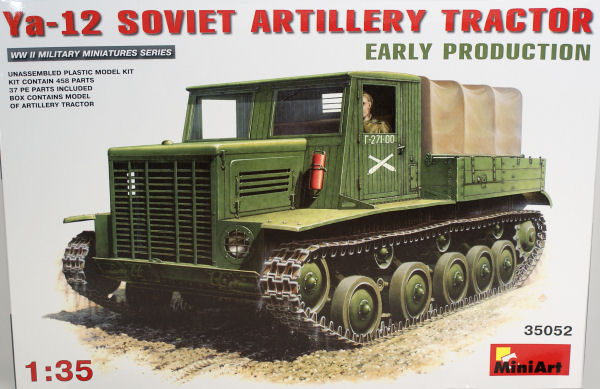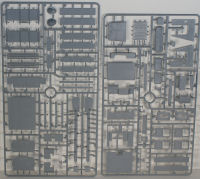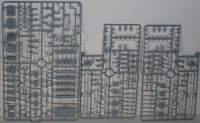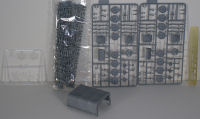
MiniArt 1/35 Ya-12 Soviet Artillery Tractor Early Production Kit First Look
By Cookie Sewell
Images by Michael Benolkin
| Date of Review | August 2012 | Manufacturer | MiniArt |
|---|---|---|---|
| Subject | Ya-12 Soviet Artillery Tractor Early Production | Scale | 1/35 |
| Kit Number | 35052 | Primary Media | 485 parts (442 in grey styrene, 37 etched brass, 6 clear styrene) |
| Pros | First kit of this vehicle in styrene; compliments Soviet corps-level artillery pieces | Cons | Nothing major noted |
| Skill Level | Experienced | MSRP (USD) | $53.99 |
First Look
 |
 |
 |
It did not take the Soviets long to figure out their heavier artillery pieces needed to switch from horse-drawn to mechanical drayage and even during the late 1930s they began creating suitable tractors for use as prime movers. The two most prevalent ones, the "Stalinets" and the "Voroshilovets", soon showed themselves to be functional but complex and closing on obsolescence. As a result, in 1942 the Automotive Scientific Technical Institute (NATI) began working on a design for a twin-engined prime mover using GAZ-MM truck engines. But as the Gor'kiy Automotive Plant (GAZ) was working full bore on their GAZ-MM and GAZ-AAA trucks plus the T-70 series of light tanks, they could not meet any external demands for engines.
The development of the new tractor had been tasked to the Yaroslavl' Automotive Plant (YaAZ) and they developed the Ya-11, but as it used the GAZ-AA engines they had to find another source. Happily, the US was shipping them a large number of GMC 4-71 supercharged four-cylinder diesel engines that produced 110 HP which was perfect for their use. The new vehicle, re-engined with GMC diesel, was dubbed the Ya-12.
The original design had used many GAZ parts other than the engines, and that included the running gear of the T-60 light tank. As a result, the first Ya-12 tractors built all had T-60 running gear as well, but later switched to a cast six-spoke road wheel among other improvements. Between August 1943 and May 1945 1,666 Ya-12 prime movers were built, and at least 1,270 were still in service at the end of the war.
Since the little tractor had a drawbaw pull of 8,000 kilograms, it was well suited for most of the Soviet towed medium and heavy artillery, including the 100mm BS-3 antitank gun, the 122mm A-19 corps gun, the 152mm ML-20 gun/howitzer, or even on occasion the mighty 203mm B-4M howitzer. But it could be found with other pieces as well, such as the 122mm M-30 or 152mm D-1 howitzers.
Miniarm has now released a lovely kit of this little tractor, which is good timing as companies such as Trumpeter have released the A-19 and ML-20 so these guns now have a prime mover. With nearly 500 parts to it, this is a very detailed little beast and presents a excellent representation of the vehicle.
The GMC 4-71 engine, blower and transmission are made up of 36 parts and provide plenty of detail for this motor. Each torsion bar suspension is built up from a case, two bars, two supports, and two end units. Five assemblies are joined to the side frames to create the chassis, and front and rear beams lock it in place. The first 21 steps in the directions cover the assembly of the engine and chassis, and the directions are neatly drawn and CLEAR.
Step 22 begins construction of the cab, which includes all of the simple but sturdy controls used with the tractor.
The headlight is installed in the left fender box in Step 27; due to its construction, this will be difficult to replace with a lens such as an MV Lens or other reflective resin product. It has to be installed prior to assembly of the fender box, which covers the storage batteries as well.
The doors use a "sandwich" construction that permits the windows to be placed at any height the modeler desires from full up to full down; it would appear these are the old-fashioned leather strap type as no crank element is provided.
The hood is assembled and installed in Step 30, but the directions show it cemented in place which negates all the work done on the engine. The tracks are also installed here, 87 links per side leaving six extras.
The seats may be installed up or down, and Steps 31-32 show how this is done.
A molded body tarpaulin is provided and is also fitted with flaps along the side to replicate being fastened to the body. However, no fasteners or rope rigging directions are included, so I am not sure how it attached in real life.
Four finishing options are included, but no units are indicated: all are in 4BO green. Note that during this period of the war the entire vehicle was painted that color and the frame was NOT black. The options are: white square 1; D2; registration number G-271-00 with crossed cannons; and 3. A small sheet of decals is provided for these markings.
Overall this is a gorgeous little model. While it may seem expensive, modelers need to stop and think that this is probably going to be a low-volume kit and that MiniArt does need to recover its expenses; still, it is a great option and gives modelers yet another option for prime movers.
Thanks to MRC for the review sample.
Sprue Layout:
- A 67 Chassis details, engine
- B 33 Body, chassis
- C 43 Cab, interior details
- D 59x2 Body details, road wheel arms, drivers, frames, bows
- E 6 Clear styrene
- F 1 Tarpaulin (body cover)
- G 12x15 Single track links
- PE 37 Etched brass







